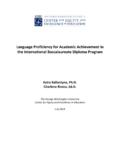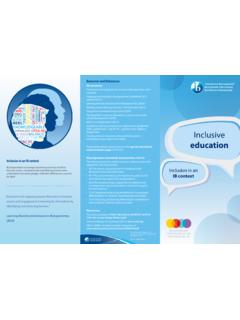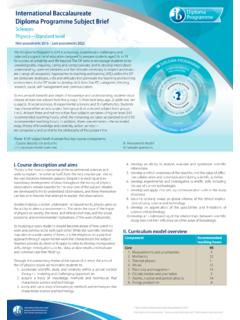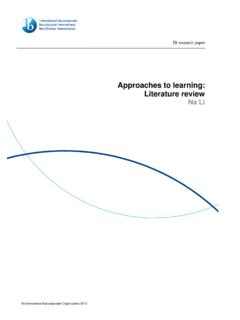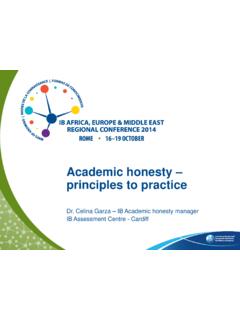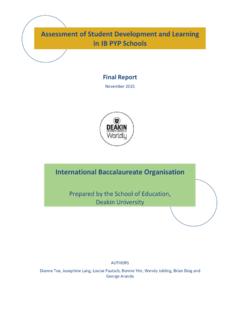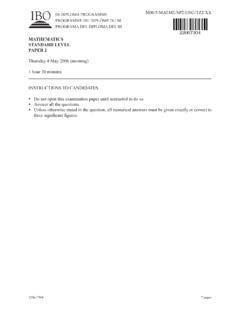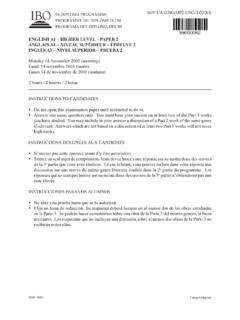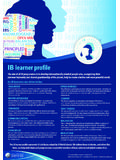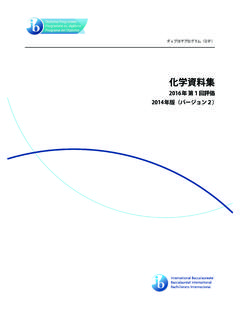Transcription of Approaches to learning: Literature review - ibo.org
1 IB research paper Approaches to learning: Literature review Na Li 1. international international Baccalaureate LanguageBaccalaureateOrganization 2012. Organization A teacher support material: 2010interim objectives Example Contents Executive Introduction .. 1. 1. Overview of This Literature review .. 2. 1. Approaches to Learning Related Theories ..4. Emerging Educational 4. Multiple Intelligence Theories.. 4. Critical thinking.. 4. Creative thinking skills.. 5. Metacognitive and self-regulation skills.. 5. Affective, social skills.. 5. Major Perspectives of Learning and Instruction .. 5. Constructivist perspectives of learning.. 5. Student-Centred learning and instruction.. 5. Technology enhanced learning and instruction.. 5. Summary .. 6. 2. Implementation of Constructivist and Student-Centred Learning Approaches ..6. Curriculum, Pedagogy and Assessment: From Cognitive and Metacognitive Perspectives .. 6. Inquiry-based learning.. 6. Problem-based learning.
2 7. Situated and embodied cognition model.. 8. Self-regulated 9. Cognitive apprenticeship model.. 10. Effective collaborative learning.. 10. Integrative approach of curriculum design.. 11. Summary .. 11. Curriculum Design & Pedagogy: from Affective, Sociocultual Perspectives .. 12. Addressing students' motivation in the classroom.. 12. Establish self-relevance in the curriculum.. 13. Establish positive teacher-student relationship.. 13. Summary .. 13. Contemporary Views of Assessment: Assessment for 14. Delineate achievement criteria and write clear learning outcome statements.. 14. Differentiated 15. Summary .. 16. Summarize Major Challenges in Implementing Student-Centred Learning Approaches .. 16. Some Suggestions Addressing the 17. Construct a clear framework of goals and case-based description of the learning models.. 17. Account for individual differences and cultural diversity.. 17. Align assessment with the constructive, student-centred learning models.
3 17. Collaborative inquiry models for professional development.. 18. Summary .. 18. 3. Age Appropriateness Addressed in the Implementation of Student-Centred Learning Approaches .. 19. Cognitive, Social-cognitive, Affective Development.. 19. Piaget's cognitive development theories and its implications.. 19. Vygotsky's sociocultual theory of development and its implications.. 20. The development of social cognitive skills and affective skills.. 21. Implications from the Developmental Theories on Curriculum, Pedagogy and Assessment .. 23. Developmentally appropriate curriculum.. 23. Developmentally appropriate pedagogy and instruction.. 23. Guided participatory curriculum at elementary level: A balance between student Initiated activities and teacher's intervention.. 24. The role of content knowledge in student-centred curriculum and pedagogy.. 24. Age appropriate assessment.. 25. Summary .. 26. 4. Concluding Remarks: Implications for the IB's Three Program and Program Transition.
4 27. Problems in the Transition across the Three IB programs .. 27. Potential Strategies Facilitating PYP-MYP-DP Transition: More Action Research Needed .. 29. Coherence and consistency of curriculum objectives and standards across PYP-MYP-DP.. 29. Alignment of 30. Aligned Assessment Approaches in PYP-MYP-DP.. 31. Special Transitional Programs & Teacher Training .. 32. 5. Summary: Limitations & Suggestions for Future Research .. 32. References .. 34. Appendix A. General guidelines and implementation examples in US common core, European framework, Hong Kong Curriculum Development Council .. 43. Appendix B. Inquiry-based Learning Approach Examples----An Inquiry Cycle .. 44. Approaches to learning: Literature review Executive summary Introduction The international Baccalaureate's (IB) major objectives are to develop inquiring, knowledgeable and caring young people who help to create a better and more peaceful world through intercultural understanding and respect and to encourage students to become active, compassionate and lifelong learners (IB 2008).
5 To align with these goals, it is essential to implement student-centred and constructivist learning Approaches supporting whole-person development. Over the last decade, there has been a rapid growth in the number of schools offering the IB's four programmes throughout the world (Hallinger, Lee and Walker 2011). The four IB programmes the Primary Years Programme (PYP, 3 12 years), the Middle Years Programme (MYP, 11 16 years) and the Diploma Programme (DP) and Career-related Certificate (IBCC) (16 19 years) were established at different times without much inter-programme linkage. The DP was first established in the 1960s, the PYP and the MYP were established in the 1990s, and the IBCC was introduced in 2011. It should be noted that because the IB has only just introduced the IBCC, it is not discussed in this paper. The three traditional programmes (PYP, MYP. and DP) have different structures and are self-contained, which makes it difficult to make a smooth transition across programmes (Bunnell 2011).
6 For a continuum of international education , the question of how to design aligned curriculum, pedagogy and assessment across different developmental stages needs to be answered. Cross-cultural differences are another important issue to be addressed in implementing various student-centred learning Approaches , as well as in the programme transition. Based on these important issues for the development of the IB, four research questions are delineated and discussed in this Literature review . This Literature review includes four major parts, and each addresses one research question (RQ). RQ1: How are Approaches to learning related theories and practices perceived and outlined in the curriculum of various national and international educational systems? What are their commonalities in terms of goals, objectives, components and other considerations? RQ2: How are these perspectives unpacked and implemented in practice, for example, integration with the school-based curriculum, pedagogical strategies and inclusion in teacher training?
7 RQ3: How is the issue of age-appropriateness addressed, that is, how are connections between metacognitive, cognitive, affective and sociocultural development of children and young adults and these learning Approaches and skills specified? RQ4: What are the implications for the development of the IB's programmes to ensure the transition between and across different stages of learning? Method This is a Literature review project focusing on Approaches to learning related theories and their implementation at the school and classroom levels. To answer the four research questions, an extensive search and review of the existing relevant Literature was conducted. The sources reviewed in this paper come from four major sources: (1) academic books from the library of Teachers College, Columbia University; (2) peer-reviewed journal articles from digital databases including PsycInfo, Web of Science, Eric, and Google scholar; (3) government curriculum guidelines and documents online; (4) other online electronic resources.
8 Approaches to learning: Literature review 1. Some of the sources were obtained through the snowballing method by checking the references lists of the existing sources. Overview of this Literature review In section 1, common educational objectives across national and international educational systems are reviewed. A balanced emphasis on knowledge and higher-order thinking skills can be found in the curriculum guidelines of various educational systems. Critical-thinking, creative-thinking, metacognitive and self-regulation, social and affective skills are briefly discussed in section Constructivist and student-centred Approaches are very important to achieving these educational objectives; thus section briefly discusses some basic concepts of constructivism and student-centred learning Approaches , and how technology has introduced new opportunities for implementing constructivist and student-centred Approaches . A variety of constructivist and student-centred learning Approaches can be implemented at the classroom level and school level.
9 Inquiry-based learning is an important constructivist approach, allowing knowledge construction via asking questions. Inquiry-based learning needs to be well structured and scaffolded, and inquiry cycles can be effectively applied in various educational settings. Problem-based learning refers to students working in small groups to solve authentic problems, in which inquiry strategies are usually involved. Constructivist Approaches assume that learning is situated in context; the situated and embodied cognition model is discussed in section as an important constructivist learning approach. These learning Approaches are not mutually exclusive; classroom level practices may involve a variety of learning Approaches for specific learning goals. Developing students' metacognitive ability and learning skills is an important learning objective, and section discusses how to practise self-regulated learning skills at the classroom level. Although these constructivist and student-centred learning Approaches are emphasized in the IB's programmes, many issues such as how to provide the proper level of scaffolding in inquiry-based learning.
10 And how to integrate content and skills learning well still require further exploration. The cognitive apprenticeship model provides practical strategies regarding instructional scaffolding (see section ). Collaborative learning (see section ) could facilitate knowledge construction in many contexts, but its effective implementation depends on many factors such as students' prior knowledge and age-related characteristics such as social cognitive ability. In designing collaborative learning, these factors need to be addressed. Section discusses the distinctions between an integrative approach and an interdisciplinary approach in curriculum design, which aligns with the distinction between the transdisciplinary approach in the PYP and the interdisciplinary approach in the MYP. Affective and sociocultual perspectives are also important aspects in the constructivist learning models (see section ). Topics such as students' motivation and teacher student relationship are covered.
